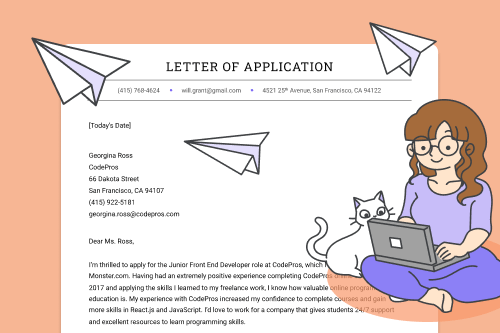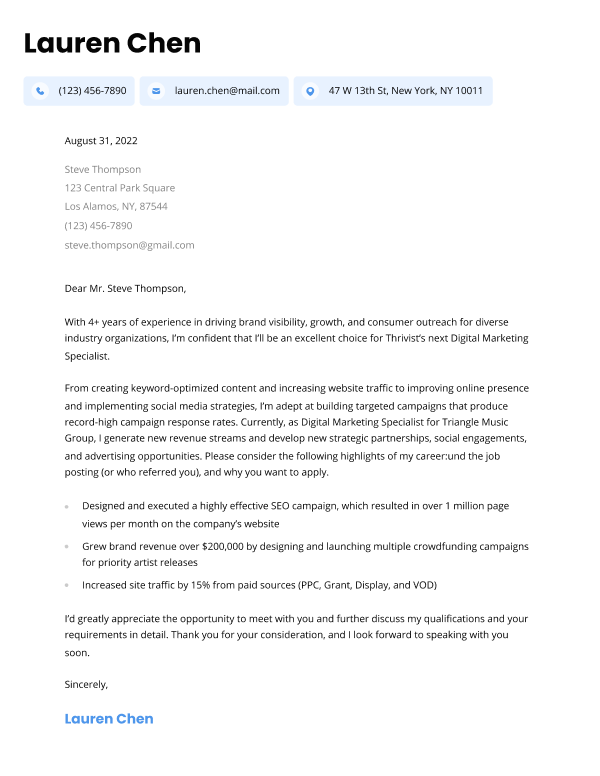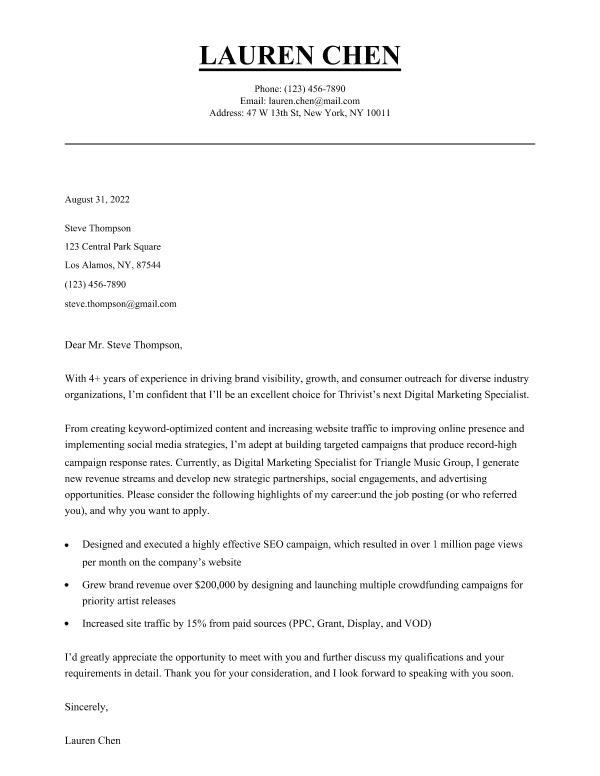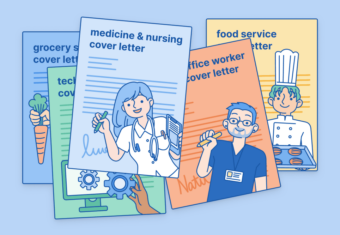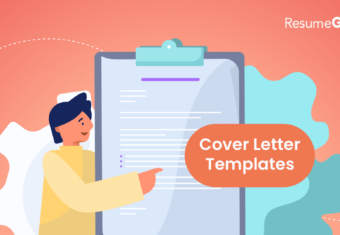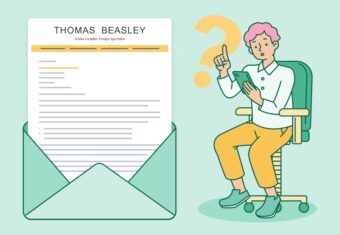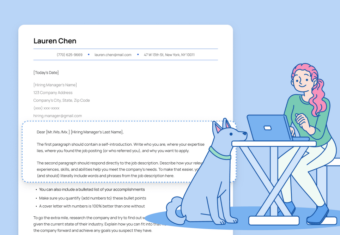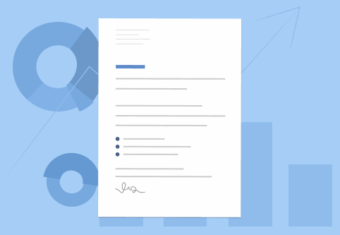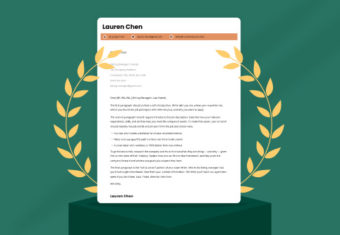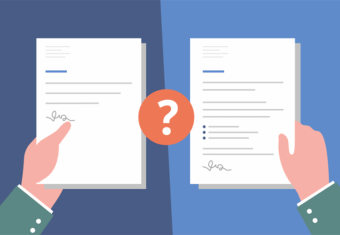While there are many purposes for a letter of application, it’s generally intended to give employers more information about you and why you’re applying.
Here’s an example of a simple job application letter:
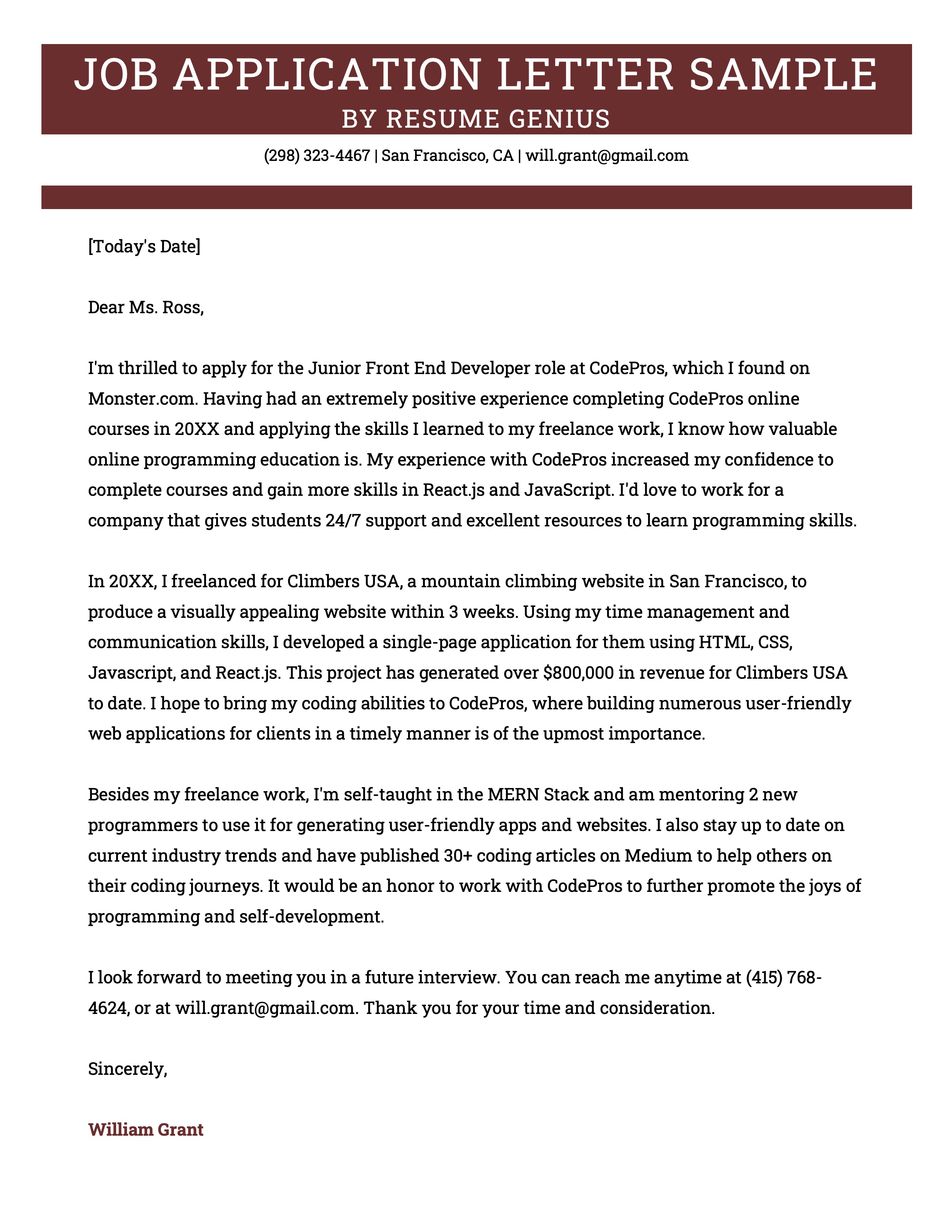
Letter of Application Template (Text Version)
CodePros
66 Dakota Street
San Francisco, CA 94107
(415) 922-5181
georgina.ross@codepros.com
Dear Ms. Ross,
I’m thrilled to apply for the Junior Front End Developer role at CodePros, which I found on Monster.com. Having had an extremely positive experience completing CodePros online courses in 2017 and applying the skills I learned to my freelance work, I know how valuable online programming education is. My experience with CodePros increased my confidence to complete courses and gain more skills in React.js and JavaScript. I’d love to work for a company that gives students 24/7 support and excellent resources to learn programming skills.
In 2021, I freelanced for Climbers USA, a mountain climbing website in San Francisco, to produce a visually appealing website within 3 weeks. Using my time management and communication skills, I developed a single-page application for them using HTML, CSS, Javascript, and React.js. This project has generated over $800,000 in revenue for Climbers USA to date. I hope to bring my coding abilities to CodePros, where building numerous user-friendly web applications for clients in a timely manner is of the upmost importance.
Besides my freelance work, I’m self-taught in the MERN Stack and am mentoring 2 new programmers to use it for generating user-friendly apps and websites. I also stay up to date on current industry trends and have published 30+ coding articles on Medium to help others on their coding journeys. It would be an honor to work with CodePros to further promote the joys of programming and self-development.
I look forward to meeting you in a future interview. You can reach me anytime at (415) 768-4624, or at will.grant@gmail.com. Thank you for your time and consideration.
Sincerely,
William Grant
An effective letter of application:
- expands on the skills, achievements, and professional experiences you want to highlight
- explains your personal interest in applying to the position
- describes what you can offer the company
Sound tough? We’ve got you covered – read on to learn how to write a letter of application that gets you the job you want (even if it’s a hyper-competitive position).
Our free-to-use cover letter builder can make you a cover letter in as little as 5 minutes. Just pick the template you want, and our software will format everything for you.
How to write a letter of application (6 tips)
Before you start writing your letter of application, research the company and read the job posting carefully so you know how to describe your experience in a way that gets the employer’s attention.
Once you’ve done your preparation, follow these steps to write a letter of application that lands interviews:
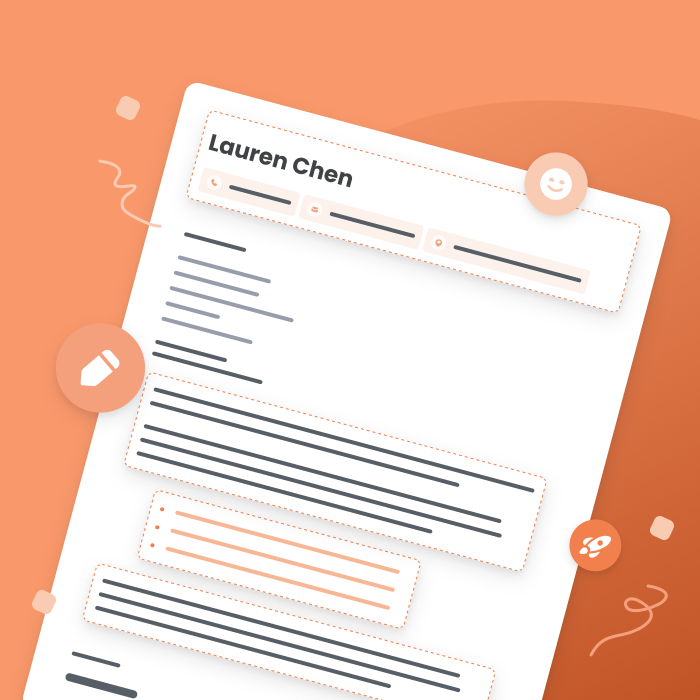
Dread writing cover letters? Read our guide to learn how to write a great cover letter that convinces hiring managers you’re the ideal person for the job.
1. Put your contact information in your letter of application header
Your letter of application’s header should match your resume header and provide your basic contact information to make it easy for hiring managers to invite you for interviews. Make sure to include your:
- name
- email address
- phone number
Depending on the job, you can also include other professional online profiles such as your portfolio or LinkedIn profile to help hiring managers learn more about your past work.
This is an example of a good job application letter header:

2. Address the hiring manager
The next part of your cover letter is the contact person’s information and a salutation (also called a greeting). To get started, write the hiring manager’s contact information at the top-left of your letter of application, including their name, company address, phone number, and email address. If the job ad doesn’t list this information, search for it online or call the company to ask for the hiring manager’s details.
Writing the date is optional in 2024. If you do include the date, place it above the employer’s contact information and format it as [Month] [Day], [Year]. For instance, January 16, 2024.
In your job application letter’s salutation, you should address the hiring manager by name to show that you’ve taken time to tailor your letter to the company. Use the format: Dear Mr./Ms./Mx. [Last Name]. If you can’t find the name, use a salutation like “Dear Hiring Manager” to avoid using the generic “To Whom It May Concern”.
Here’s how the employer’s contact information and your greeting should look:
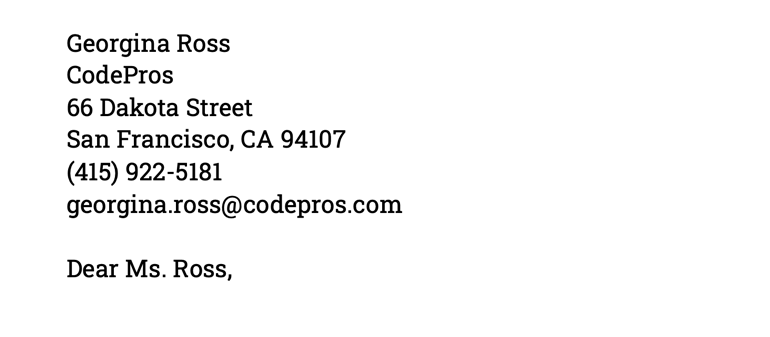
3. Grab the hiring manager’s attention with your introduction
In our recent survey of hiring managers and their thoughts on application letters, 41% said that the introduction of a job application letter leaves the biggest impression on them compared to other sections. So start your application letter off strong by:
- introducing yourself
- mentioning how you heard about the position
- explaining why you’re applying
A great example is the introduction from the letter of application example above:
I’m thrilled to be applying for the Junior Front End Developer role for CodePros, which I found on Monster.com. Having had an extremely positive experience completing CodePros online courses in 2017 and applying the skills I learned there to my freelance work, I understand how valuable online programming education can be. My experience with CodePros increased my confidence to complete courses and gain more skills in React.js and JavaScript. I’d love to work for a company that provides students with 24/7 support and excellent resources to learn programming skills.
If you’re writing a cover letter for an internal position, you don’t need to mention where you heard about the role or go over your entire professional background. Instead, highlight a couple of accomplishments from your time at the company.
This introduction catches the hiring manager’s attention because it’s tailored to the specific role and company. In our survey, 46% of hiring managers consider tailoring a letter of application to be either fairly or very important when deciding whether to invite applicants for interviews. Customizing your application letter not only demonstrates you’re a good fit for the position but also shows employers you:
- actually want to work for them
- are detail-oriented
- can do research
- are diligent (and will apply the same amount of effort to your work tasks)
Write a customized application letter for each job, even if it’s not required. Because 73% of hiring managers whose companies don’t require application letters still read them, writing an application letter is necessary to set yourself apart from the competition in 2024.
4. Highlight industry-specific skills (with numbers) in your body paragraphs
Next, add 2–4 body paragraphs with information about how your skills, experience, achievements, and education can help the target company achieve its goals. Rather than bragging, the goal of your body paragraphs is to show the hiring manager why you’d be a good fit for the position.
Match the job posting when choosing which of your hard and soft skills to highlight in your job application letter. Hard skills and knowledge are technical capabilities learned from hands-on experience, training, or education. Programming, data analysis, and user interface (UI) design are examples of hard skills.
By contrast, soft skills relate to emotional intelligence and let employers know how you interact with others in the workplace. For instance, organization skills, teamwork, and interpersonal expertise show you work well with others as well as on your own.
Your resume’s skills section should already list many of your hard skills. So use your letter of application to highlight your skills that can’t be easily tested or backed by your resume’s certifications or education section.
And just as it’s essential to quantify your achievements on your resume, it’s equally important to use hard numbers in the body paragraphs of your letter of application. Adding numbers to your application letter when other applicants only vaguely describe their qualifications will make your application memorable. The budgets you worked with, people you helped, and number of projects you were a part of can all be quantified using hard numbers.
Using numbers also shows the hiring manager the extent of what you can do. So, for example, if you’re applying to a smaller nursing home with only 50 beds, the first statement below shows you’re more than qualified to handle caregiving for their residents, while the statement without hard numbers is unclear:
Hard numbers
“I worked in a team of 8 caregivers to provide excellent customer service for 100+ residents in recreation areas and reception”
No hard numbers
“I worked in a team and provided customer service to elderly residents”
5. Choose engaging words for your application letter
Your letter of application’s length should be 250 to 400 words or 3 to 4 paragraphs — long enough to get your point across but short enough that the reader won’t lose interest. So make every word count by using strong action verbs and powerful adjectives instead of buzzwords.
For instance, buzzwords like “tasked with,” “responsible for,” and “participated in” are passive and sound like you copied responsibilities from a job posting. Instead, use verbs like “spearheaded,” “managed,” and “executed.” Here’s an excerpt from a UX designer’s letter of application that successfully uses action verbs and power adjectives:
As a Senior UX designer for Sparklabs from 2015–2017, I worked as the sole UX designer. Under minimal supervision, I systematically executed over 4 major design projects for our new website in Canada, including launching 10 prototypes based on different case studies and conducting 50+ user interviews. My innovative designs boosted our marketing campaigns by 92%, which was extremely rewarding.
Along with action verbs, descriptive adjectives help your cover letter to tell a story, which is important because stories are 22 times more likely to be remembered than facts alone. For instance, a hotel manager should include adjectives such as “courteous,” “decisive,” and “tactful” to give hiring managers a better feel for their customer service skills and way with people.
By carefully choosing adjectives for your job application letter, you also help employers evaluate whether you’re someone they’d want to work with. Notice the difference in this nurse’s experience written with and without power adjectives:
Power adjectives
In my role as a head nurse at Grey’s Hospital for 7+ years, I provided exceptional service with my kind bedside manner during emergency surgical procedures to 200+ patients per week. My cheerful demeanor brought patients a sense of calm in the emergency room.
No power adjectives
In my role as a head nurse at Grey’s Hospital for 7+ years, I provided good customer service to 200+ patients every week. I helped doctors with emergency surgical procedures in the emergency room.
6. Close your application letter with a call to action
End your application letter by inviting the hiring manager to contact you for an interview. Include your phone number and email address in your call to action to make it that much easier for a hiring manager to call you straightaway.
Finally, include an appropriate letter of application sign-off such as “Sincerely” or “Best Regards,” followed by your name.
Sincerely,
Will Grant
Putting an electronic or real signature between your sign-off and your typed name is optional.
How to format your letter of application
Unsure how to format your letter of application? Here are 4 tips for formatting an application letter so it stands out to employers:
1. Choose an appropriate font and font size
An appropriate application letter font size is between 10.5 to 12 points. Using a suitable font size ensures readability and that there’s enough white space throughout your letter, making it look professional.
Also, you should pick a professional letter of application font like:
- Times New Roman
- Arial
- Verdana
- Georgia
Professional fonts are easily scanned by applicant tracking systems (ATS), which is software that filters applications for keywords. An ATS might not be able to read your letter of application if you use uncommon fonts.
2. Fix your margins
Properly sized margins help create the perfect mix of white space and text, making your letter of application easy to read. The standard size for application letter margins is 1″, the default on Microsoft Word. However, you can adjust your margins between ½” and 1½”:
If you have a lot of relevant experience that addresses the job posting you’re responding to, changing your margins to ½” to fit more text on the page is fine.
If you have less experience to describe, you can adjust your margins up to 1½” to make your letter appear longer.
Just keep in mind that very wide margins look unprofessional, while extra narrow margins make your application letter look cluttered.
3. Save your file as a PDF
Job application letters should always be saved as a PDF file to ensure that your letter gets picked up easily by ATS software and passed onto employers. PDFs also keep your formatting intact and don’t allow others to modify your application.
Save your letter under an appropriate file name, such as “First-Name-Last-Name-Application-Letter.pdf”. Using a professional file name makes it easy for hiring managers to find your application in their inbox or on their desktop.
Always review each job posting carefully for keywords to use in your application. Adding these keywords enables your application to be read by ATS as well as demonstrates to the employer you’re a good fit for the role.
4. Simplify your formatting for letters sent in the body of an email
There are a few details to remember if you write an email letter of application for an employer.
First, write a professional subject line that shows your intent. Make sure your email subject line contains your name and the exact job title you’re applying for.
Your Name – Application for [Job Title] at [Company Name]
Second, in an email letter of application, there’s no need to type out the hiring manager’s contact information and the date (this information is already included in the email). So begin with the salutation, addressing the hiring manager using “Dear Mr./Ms./Mx. [Last Name],”.
Dear [Mr./Ms./Mx.] [Hiring Manager’s Last Name],
It’s my pleasure to apply as a [Job Title] at [Company Name].
Third, before emailing your letter of application, list your contact information below your email signature.
Sincerely,
Your Name
Phone: (xxx) xxx-xxxx
Email: your.name@gmail.com
LinkedIn: www.linkedin.com/in/yourname
Here’s an example of a job application letter sent as an email:
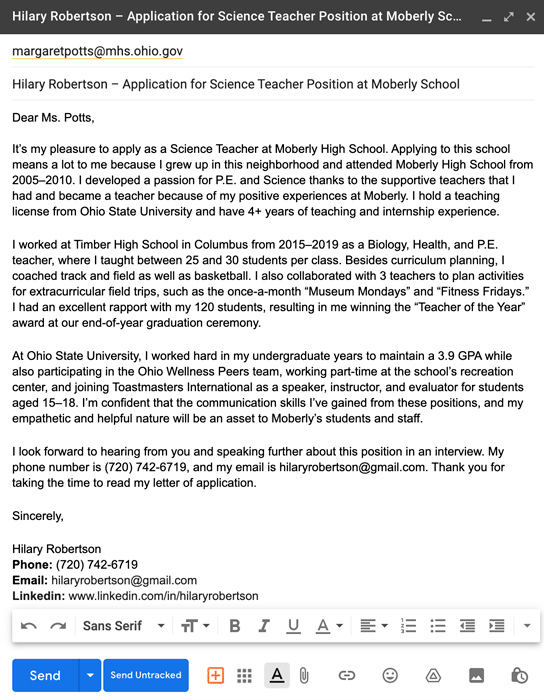
Frequently asked questions about application letters
Want more information on how to write a job application letter? Below we provide answers to 3 common questions related to application letter writing:
1. Is a letter of application the same as a cover letter?
A letter of application for a job is the same as a cover letter. Often recruiters and hiring managers will use the terms interchangeably to refer to a letter sent to give a hiring manager more information about your qualifications.
But application letters (or letters of application) for academic programs and scholarships differ from cover letters. Compared to a cover letter, an application letter for academic purposes is:
- tailored to the academic program or scholarship’s goals, rather than a specific job
- often longer (acceptable to be 1–2 pages)
- accompanied by other application materials (e.g., your transcript, resume for college, personal statement)
2. What should I avoid writing in a letter of application?
Avoid common application letter red flags, which include:
- addressing the company incorrectly (such as sending a letter of application you wrote for a different job)
- lying about your qualifications
- speaking negatively about previous jobs or employers
- including personal information not relevant to the job
- typos or grammar mistakes
3. How do I write a job application letter that stands out?
To write a job application letter that stands out, explain how your qualifications match the requirements in the job posting. Identify a few of the most important requirements that match your background and skills and provide concrete evidence for them, such as numbers or quotes from previous employers or coworkers.
Other ways to help your application stand out include:
- using skills-based keywords from the job ad
- mentioning a particularly impressive achievement
- striking the right tone (e.g., showing your humor and personality while still being professional)
- using a clean and engaging application letter template
Additional Letter of Application FAQs
Read our answers to other application letter–related questions:
Click to rate this article
4.5 Average rating


